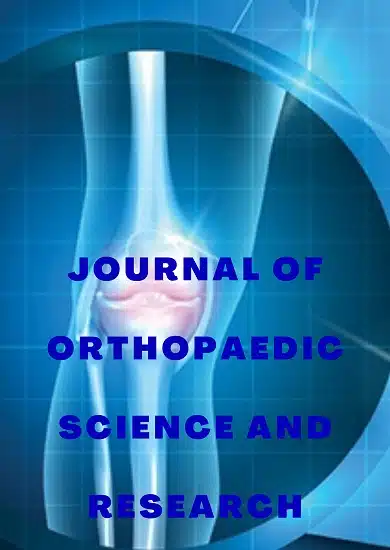Research Article | Vol. 6, Issue 1 | Journal of Orthopaedic Science and Research | Open Access |
Two-Year Outcomes of Novel Dual-Mobility System in Revision Total Hip Arthroplasty
Michelle A Richardson1, Muhammad A Haider1, Farouk Khury1,2, Nihir Parikh3, Paul Maxwell Courtney3, Chad Krueger3, Ran Schwarzkopf1*
1Department of Orthopedic Surgery, NYU Langone Health, New York, NY, USA
2Division of Orthopedic Surgery, Rambam Medical Center, The Ruth and Bruce Rappaport Faculty of Medicine, Haifa, Israel
3Rothman Orthopaedic Institute, Thomas Jefferson University Hospital, Philadelphia, PA, USA
*Correspondence author: Ran Schwarzkopf, MD MSc, Department of Orthopedic Surgery, NYU Langone Health, NYU Langone Orthopedic Hospital 301 E 17th St New York, NY 10003, USA; Email: [email protected]
Citation: Richardson MA, et al. Two-Year Outcomes of Novel Dual-Mobility System in Revision Total Hip Arthroplasty. J Ortho Sci Res. 2025;6(1):1-9.
Copyright© 2025 by Richardson MA, et al. All rights reserved. This is an open access article distributed under the terms of the Creative Commons Attribution License, which permits unrestricted use, distribution, and reproduction in any medium, provided the original author and source are credited.
| Received 13 February, 2025 | Accepted 28 February, 2025 | Published 07 March, 2025 |
Abstract
Background: Revision Total Hip Arthroplasty (rTHA) is projected to increase substantially in volume. Dual-Mobility (DM) implants, composed of articulating surface between femoral head and liner, have gained popularity for their potential to reduce hip instability and dislocations due to the larger DM femoral head options. This study aimed to evaluate early outcomes and survivorship of a novel DM implant for rTHA.
Methods: This was a retrospective, multicenter study to assess clinical outcomes of 199 patients undergoing rTHA with a novel DM implant from April 2018 to July 2023. Patient demographics, clinical outcomes and implant survivorship were collected and analyzed. Primary outcomes included 90-day Emergency Department (ED) visits and readmissions, reoperations, revisions and overall implant survivability. Preoperative and postoperative Hip Disability and Osteoarthritis Score for Joint Replacement (HOOS, JR) were also analyzed.
Results: 108 patients achieved minimum 1-year of clinical follow-up and 50 patients achieved minimum 2-years of clinical follow-up. Patients who received the novel DM implant were a mean of 67.3 years old, with the majority of the patients being women (58.0%) and of white race (68.0%). Mean BMI of patients was 29.5. Five patients (2.51%) had 90-day ED visits and readmissions due to dislocation (n = 3, 1.5%) and infection (n = 2, 1%). Two patients (1%) had revision of the acetabular component due to instability and one (0.5%) underwent close reduction a the dislocated rTHA. Patients experienced significant improvements in mean HOOS, JR scores at all postoperative time points, surpassing the minimally clinically important difference for HOOS, JR (18.0).
Conclusion This novel DM acetabular implant demonstrated excellent survivorship of the acetabular component up to 4 years (99% [95% confidence interval (CI) 0.978 – 0.995], for both) of follow-up in complex rTHA cases, with low rates of instability and no reported episode of metallosis. Patients demonstrated clinically significant improvements in HOOS, JR at 2-years post-op.
Keywords: Revision Total Hip Arthroplasty (rTHA); Dual Mobility (DM): Clinical Outcomes; Patient-Reported Outcome Measures (PROMs)
Level of Evidence: III
Introduction
Since the beginning of the era of modern Total Hip Arthroplasty (THA) in the 1970s, hip arthroplasty has evolved to become one of the most successful elective surgeries with excellent clinical outcomes [1]. Despite the notable achievements in both surgical approach and implant design, revision burden has persisted in the last few decades [1,2]. In primary THA, the most common reasons for revision include instability, mechanical loosening, and implant failure [2,3]. In revision THA, failure is seen secondary to infection, instability, and mechanical loosening [4].
The number of revision total hip arthroplasty is projected to grow substantially with THA being performed in younger, more active patients [5]. Given such recent population-estimates, it is of increasing importance to identify appropriate implants to be used in revision arthroplasty. Over the last several decades, great attention has been paid to the development of new biomaterials and bearing surfaces [6]. While ceramic on polyethylene is considered the gold standard bearing surface for primary THA, the approach to revision arthroplasty is more heterogeneous and dependent on surgeon preference as well as cause for instability. In 1974, Gilles Bousquet proposed the concept of dual-mobility to improve hip stability [7]. The Dual-Mobility (DM) implant consists of a fixed acetabular shell with a polished inner surface which articulates with a mobile liner that articulates with the femoral head [8]. DM implants are thought to improve stability by increasing the femoral head jump distance [8,9]. While DM implants have been found to have decreased dislocation rates in revision THA, there are also reported complications including risk of metal wear leading to elevated metal ions and metal particle disease [10,11]. Newer DM designs utilize novel metal alloys, such as zirconium niobium rather than cobalt chrome or titanium, to reduce the rate of such complication [12-15].
The present study aims to evaluate a novel modular DM implant that utilizes an oxidized zirconium niobium alloy in both the femoral head and acetabular liner for use in revision THA. We hypothesized that the use of this novel implant would demonstrate low perioperative complication rates, low metal complication rates, and satisfactory Patient-Reported Outcome Measures (PROMs).
Methods
Study Design
This was a multi-center retrospective cohort study conducted to assess a novel revision acetabular cup system in THA (REDAPT Revision Acetabular SystemTM, Smith and Nephew, Memphis, TN). Following Institutional Review Board (IRB) research protocol approval, we conducted a retrospective review of 2,298 revision THA’s performed from July 2016 to August 2023. Patients were included in the study if they underwent revision THA utilizing the novel acetabular cup system and the novel DM system (OR3O XLPE liner, Smith & Nephew, Memphis, TN) constructs (Fig. 1). All included patients received an Oxinium femoral head (Fig. 2,3). Patients were excluded from the study if they underwent primary THA, bilateral THA or were <18 years of age. Our final study population, after exclusions, consisted of 199 patients.
Data Collection and Outcome Measures
At both institutions the Electronic Medical Record (EMR) database (Epic Caboodle Version 15; Verona, Wisconsin) was utilized to collect patient demographics including age, sex, race, Body Mass Index (BMI), smoking status and American Society of Anesthesiologists (ASA) class. Primary outcomes included re-revision of the acetabular modular cup and the DM liner, indication for re-revision and time to re-revision. Data regarding 90-day surgery-related readmissions were also collected. Patient-Reported Outcome Measures (PROMs) collected included the Hip dysfunction and Osteoarthritis Outcome Score for Joint Replacement (HOOS, JR) score collected preoperatively and at 6 weeks, 3 months, 1 year and 2 years postoperatively.
Data Analyses
Descriptive statistics were performed and reported including means, standard deviations and ranges. Survivorship analysis was performed using the Kaplan-Meier method. All statistical analysis was performed using SPSS statistics (Version 28.0.1.1, Armonk, NY). Baseline characteristics of patients were represented as count with percentages for categorical variables and means ± standard deviations for continuous variables.
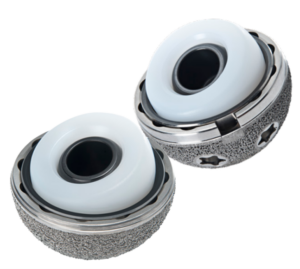
Figure 1: OR3O XLPE liner, Smith and Nephew, Memphis, TN.
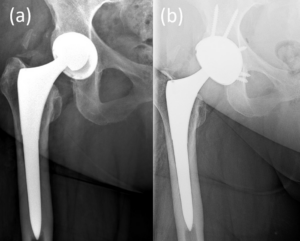
Figure 2: (a) Pre- and (b) Postoperative anteroposterior hip plain radiograph of an acetabular cup revision with the OR3O XLPE liner, Smith & Nephew, Memphis, TN, indicated by fractured liner and metal wear.
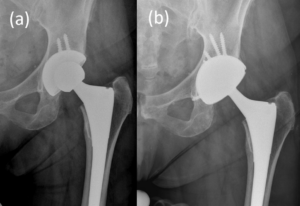
Figure 3: (a) Pre- and (b) Postoperative anteroposterior hip plain radiograph of an acetabular cup revision with the OR3O XLPE liner, Smith and Nephew, Memphis, TN, indicated by aseptic loosening and wear.
Results
Of the 199 rTHAs, the mean age was 67.4 (29 to 94) years (Table 1). 57.8% and 42.2% of the study population were females and males, respectively. The average BMI of the study cohort was 29.5 kg/m2 (16.5-54.4). 67.8% of all patients were of white race and 81.4% were never smokers. The majority of patients (59.3%) had an ASA class of 3 and 50.8% of patients underwent a left sided procedure. A full account of the descriptive demographics can be found in Table 1.
108 patients (54.3%) achieved a minimum of 1-year of clinical follow-up and 50 patients (25.1%) achieved a minimum of 2-years of clinical follow-up. Five patients (2.51%) visited the Emergency Department (ED) and were readmitted due to a surgery-related cause within 90 days of surgery (Table 2). Three (1.5%) and two (1%) of these were due to dislocation and Periprosthetic Joint Infection (PJI), respectively. Two (1%) of the dislocated rTHAs required acetabular revision surgery, where the acetabular cup and DM liner were exchanged, and the third patient (1%) underwent closed reduction of the hip. Four patients (2%) were diagnosed with PJI, three (1.5%) required Debridement, Antibiotics and Implant Retention (DAIR) and one (0.5%) underwent two-stage revision arthroplasty. Other than the two (1%) dislocation cases that required acetabular revision surgery and one (0.5%) two-stage revision arthroplasty case, there were two (1%) patients that underwent revision for Periprosthetic Fracture (PPF) of the femoral shaft, with retention of the DM acetabular construct within our study cohort, which were not factored into the DM acetabular implant survivorship. There were no cases of Metal-on-Metal (MoM) corrosion or metal ion disease reported in the cohort. Our study cohort had a 99% survival from both aseptic and septic acetabular revisions at up to 4-years of follow-up (Fig. 4). A full account of clinical outcomes can be found in Table 2.
Patients had an average preoperative HOOS, JR score of 51.15 with a standard deviation of 15.18. Patients experienced an improvement of HOOS, JR scored at each postoperative time point including 6 weeks, 3 months, 1 year and 2 years of follow-up. Patients experienced an average of 23.85 improvement in HOOS, JR scores from preop to 2-years postop, with a SD of 18.58. This improvement in HOOS, JR scores achieved the Minimally Clinically Important Difference (MCID) for HOOS, JR (Table 2) for a full account of HOOS, JR scores.
Demographic | rTHA (n=199) |
Mean Age (years) [range] | 67.4 [29-94] |
Sex, n (%) Men Women | 84 (42.2) 115 (57.8) |
Race, n (%) White African American Asian Other | 135 (67.8) 31 (15.6) 3 (1.5) 30 (15.1) |
Mean BMI (kg/m2) [range] | 29.5 [16.5-54.4] |
Smoking Status, n (%) Never Current | 162 (81.4) 37 (18.6) |
ASA Class, n (%) 0 1 2 3 4 | 4 (2.0) 3 (1.5) 73 (36.7) 118 (59.3) 1 (0.5) |
Procedure Laterality Right Left | 98 (49.2) 101 (50.8) |
rTHA: revision Total Hip Arthroplasty; BMI: Body Mass Index; ASA: American Society of Anesthesiologists. | |
Table 1: Baseline characteristics.
Outcome | rTHA (n = 199) |
90-day surgery-related ED visit, n (%) Infection Dislocation | 5 (2.51) 2 (1) 3 (1.5) |
90-day surgery-related readmission, n (%) Infection Dislocation | 5 (2.51) 2 (1) 3 (1.5) |
Reoperation, n (%) DAIR | 3 (1.5) 3 (1.5) |
Revision, n (%) Acetabulum-only Dislocation Femur-only PPF Both-component Two-stage revision | 5 (2.51) 2 (1) 2 (1) 1 (0.5) |
Mean HOOS, JR (SD), n Preoperative 6 weeks 3 months 1 year 2 years Δ Preop to 6 weeks Δ Preop to 3 months Δ Preop to 1 year Δ Preop to 2 years | 51.15 (15.18) 61.51 (17.68) 70.00 (18.98) 72.69 (22.60) 75.00 (21.98) 10.36 (16.43) 18.85 (17.08) 21.54 (18.89) 23.85 (18.58) |
rTHA: Revision Total Hip Arthroplasty; ED: Emergency Department; PPF: Periprosthetic Fracture; HOOS, JR: Hip Disability and Osteoarthritis Outcome Score, Joint Replacement; SD: Standard Deviation | |
Table 2: Clinical and patient-reported outcome measures.
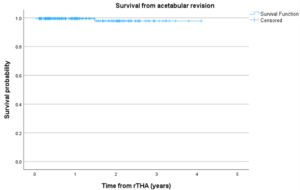
Figure 4: rTHA Survival from acetabular revision.
Discussion
In the present study, the use of a novel DM acetabular implant in the setting of complex rTHA cases demonstrated excellent survivorship of the acetabular component at 1 and 2 years (99%, for both). Additionally, there were low rates of instability with only two patients requiring revision of the acetabular component due to instability. There were no cases of metal-on-metal corrosion or metal ion disease reported in the cohort. Patients demonstrated clinically significant improvements in HOOS, JR at 2-years post-op.
The performance of the novel DM acetabular implant for revision cases is comparable to the existing literature. In a systematic review, Saroha, et al., noted benefit in all-cause revision and revision secondary to dislocation, as well as overall lower complication rates of infection and dislocation [16]. Another study comparing survivorship of DM and constrained liner bearings found no difference at 12 months follow-up [17]. Reina, et al., performed a systematic review of six studies with revision THA and found excellent mid-term survivorship compared to non-dual-mobility articulations [18]. The overall dislocation rate was 2.2% in the DM group compared to 7.1% in the control group at 4.1 years mean follow-up [18]. There were also fewer overall re-revision, re-revision for dislocation, and aseptic loosening in the DM group [18]. Weintraub, et al., performed a randomized controlled trial that compared dislocation rates between DM versus large femoral heads (≥36 mm) in revision total hip arthroplasty and found no difference, with two in the DM cohort (2.6%) and three in the large femoral head cohort (4.3%) [19]. In contrast, Otero, et al., found that DM bearings have lower rates of instability compared to patients who had ≤32 mm heads but higher revision rates for ≥36 mm heads [20]. Our study showed the stability of DM implants in the revision setting with only three patients (1.5%) experiencing a dislocation. Only two patients (1%) experienced an acetabular revision surgery for dislocation, where the acetabular cup and DM liner were exchanged. These results are superior to other reported DM implants commonly used today [21-23].
Despite the potential for DM use in the revision setting, it is important to recognize their unique complications. The risk of dislocations is of particular interest given the overall increased rates of this complication in the revision setting [24]. Unique to the DM implants, intra-prosthetic dislocations refer to a dissociation of the femoral head from the liner. These dislocations may occur secondary to trauma or with excess force on the DM component in closed reduction attempts [19]. The current literature reports low rates of intra-prosthetic dislocation at only 2-3% [10,25]. In our cohort, there were no intra-prosthetic dislocations. While rare, these dislocations require revision of the DM head construct [10,25]. Thus, as the use of DM in the revision setting continues to increase, additional follow-up for this unique complication is necessary in future studies.
Another complication stems from the acetabular cup and liner articulation of two dissimilar metals which can lead to mechanical corrosion, in which the foreign body reaction to metal ions can result in implant failure. Kolz, et al., noted corrosion in 12 cobalt-chromium liners in a small retrieval study, whereas Hemmerling, et al., noted corrosion in 97% and microscopic fretting in 88% of 60 DM components in a similar retrieval study [26-28]. The novel DM liner implant used in our study is composed of oxidized zirconium, which is a harder metal, intentionally utilized to decrease metal-on-metal wear [26]. There were no cases of metal-on-metal corrosion or metal ion disease reported in our cohort. In the first iteration of this study for DM in primary THA, there were similarly no incidences of corrosion failure [26]. Furthermore, the implant used in our study has an inner liner taper of 18 degrees, shown to improve rates of malseating [26,29].
In terms of PROMs, patients experienced an average of 23.85 improvement in HOOS, JR scores from preoperatively to two years postoperatively, with a SD of 18.58 [30]. This improvement in HOOS, JR scores achieved the Minimally Clinically Important Difference (MCID) for HOOS, JR [31]. These PROMs of the investigated novel DM acetabular implant are comparable to those found in the literature. Colacchio, et al., studied 143 monoblock MoM THAs that were revised to either a DM construct or complete revision of the acetabular component and found favorable HOOS JR scores with a mean of 85.3 for the DM construct. Dikmen, et al., additionally found excellent Harris Hip Scores (HHS) at an average follow-up of 3.5 years in 34 hips undergoing revision with a DM construct, increasing from a mean of 42.8 preoperatively to 87.3 postoperatively [32].
There are several limitations that should be acknowledged. First, the data is limited to that provided by two institutions from major metropolitan cities and therefore not necessarily generalizable to the broader population. Future studies may include data from multiple institutions both across the country and internationally. Second, follow-up at the time of this present study is limited to two years. Longer follow-up is desired especially considering the average lifespan of revision total hip replacements in the setting of an aging population. Thus, the current cohort will continue to be followed for more comprehensive five- and ten-year data in the future.
Conclusion
In the present study, we report the two-year outcomes of a novel DM acetabular implant in the setting of complex rTHA cases. In 199 patients undergoing rTHA, the novel DM implant demonstrated excellent survivorship of the acetabular component at 1 and 2 years (99%, for both). The implant performed well with regards to stability and had low rates of complications including dislocation and metal-on-metal corrosion. The rate of aseptic revision of the DM acetabular component was 1%. Overall, this study demonstrated that the novel DM is a promising choice for use in the revision total hip setting with clinically significant improvements as captured by patient-reported outcome measures at follow-up.
Conflict of Interests
Michelle A. Richardson, MD – Nothing to disclose.
Muhammad A. Haider, BS – Nothing to disclose.
Farouk Khury, MD – Nothing to disclose.
Nihir Parikh, BS – Nothing to disclose.
Paul Maxwell Courtney, MD – AAOS: Board or committee member; American Association of Hip and Knee Surgeons: Board or committee member; Journal of Arthroplasty: Editorial or governing board; Parvizi Surgical Innovation: Stock or stock Options; Smith & Nephew: Paid consultant; Stryker: Paid consultant; Zimmer: Paid consultant.
Chad A. Krueger, MD – Smith and Nephew: Type: Other Professional Activities; American Association of Hip and Knee Surgeons: Type: Board of Directors or committee member Self.
Ran Schwarzkopf, MD MSc – AAOS: Board or committee member; American Association of Hip and Knee Surgeons: Board or committee member; Arthroplasty Today: Editorial or governing board; Gauss surgical: Stock or stock Options; Intelijoint: Paid consultant; Stock or stock Options; Journal of Arthroplasty: Editorial or governing board; PSI: Stock or stock Options; Smith & Nephew: IP royalties; Paid consultant; Research support; Zimmer: Paid consultant.
Funding/Sponsorship
Not applicable
References
- Pivec R, Johnson AJ, Mears SC, Mont MA. Hip arthroplasty. Lancet. 2012;380(9855):1768-77.
- Bozic KJ, Kurtz SM, Lau E, Ong K, Vail TP, Berry DJ. The epidemiology of revision total hip arthroplasty in the United States. J Bone Joint Surg Am. 2009;91(1):128-33.
- Wiznia DH, Buchalter DB, Kirby DJ, Buckland AJ, Long WJ, Schwarzkopf R. Applying the hip-spine relationship in total hip arthroplasty. Hip Int. 2021;31(2):144-53.
- Jafari SM, Coyle C, Mortazavi SM, Sharkey PF, Parvizi J. Revision hip arthroplasty: Infection is the most common cause of failure. Clin Orthop Relat Res. 2010;468(8):2046-51.
- Shichman I, Roof M, Askew N. Projections and epidemiology of primary hip and knee arthroplasty in medicare patients to 2040-2060. JBJS Open Access. 2023;8(1).
- Khalifa AA, Bakr HM. Updates in biomaterials of bearing surfaces in total hip arthroplasty. Arthroplasty. 2021;3(1):32.
- Elbuluk AM, Slover J, Anoushiravani AA, Schwarzkopf R, Eftekhary N, Vigdorchik JM. The cost-effectiveness of dual mobility in a spinal deformity population with high risk of dislocation: a computer-based model. Bone Joint J. 2018;100-b(10):1297-302.
- Vasukutty NL, Middleton RG, Matthews EC, Young PS, Uzoigwe CE, Minhas TH. The double-mobility acetabular component in revision total hip replacement: the United Kingdom experience. J Bone Joint Surg Br. 2012;94(5):603-8.
- Arraut J, Oakley C, Shichman I, Hepinstall M, Macaulay W, Schwarzkopf R. Dual mobility versus fixed bearing implants in primary total hip arthroplasty in patients under 55 years of age. Bull Hosp Jt Dis. 2024;82(3):210-16.
- Abdel MP. Dual-Mobility constructs in revision total hip arthroplasties. The Journal of Arthroplasty. 2018;33(5):1328-30.
- Abdelaal MS, Zachwieja E, Sharkey PF. Severe corrosion of modular dual mobility acetabular components identified during revision total hip arthroplasty. Arthroplast Today. 2021;8:78-83.
- Carli AV, Patel AR, Cross MB. Long-term performance of oxidized zirconium on conventional and highly cross-linked polyethylene in total hip arthroplasty. Sicot J. 2020;6:10.
- Rudy HL, Padilla JA, Gabor JA, Iorio R, Schwarzkopf R, Vigdorchik J. Cost-effectiveness of dual mobility and a value-based algorithm of utilization. Orthop Clin North Am. 2019;50(2):151-8.
- Dankert JF, Lygrisse K, Mont MA, Schwarzkopf R. Dual mobility total hip arthroplasty in the United States: A review of current and novel designs. Surg Technol Int. 2020;36:379-87.
- Singh V, Loloi J, Macaulay W, Hepinstall MS, Schwarzkopf R, Aggarwal VK. Dual-mobility versus fixed-bearing in primary total hip arthroplasty: outcome comparison. Hip Pelvis. 2022;34(2):96-105.
- Saroha S, Raheman FJ, Jaiswal PK, Patel A. Dual-mobility implants in primary and revision total hip arthroplasty: A systematic review and meta-analysis. J Clin Orthop Trauma. 2024;54:102495.
- Chisari E, Ashley B, Sutton R Dual-mobility implants and constrained liners in revision total hip arthroplasty. Arthroplast Today. 2022;13:8-12.
- Reina N, Pareek A, Krych AJ, Pagnano MW, Berry DJ, Abdel MP. Dual-mobility constructs in primary and revision total hip arthroplasty: a systematic review of comparative studies. J Arthroplasty. 2019;34(3):594-603.
- Weintraub MT, DeBenedetti A, Nam D. Dual-mobility versus large femoral heads in revision total hip arthroplasty: Interim analysis of a randomized controlled trial. J Arthroplasty. 2023;38(7s):S206-10.
- Otero JE, Heckmann ND, Jaffri H. Dual mobility articulation in revision total hip arthroplasty: An American joint replacement registry analysis of patients aged 65 years and older. J Arthroplasty. 2023;38(7 Suppl 2):S376-80.
- Hartzler MA, Abdel MP, Sculco PK, Taunton MJ, Pagnano MW, Hanssen AD. Otto Aufranc Award: Dual-mobility constructs in revision tha reduced dislocation, rerevision, and reoperation compared with large femoral heads. Clin Orthop Relat Res. 2018;476(2):293-301.
- Leiber-Wackenheim F, Brunschweiler B, Ehlinger M, Gabrion A, Mertl P. Treatment of recurrent THR dislocation using of a cementless dual-mobility cup: A 59 cases series with a mean 8 years’ follow-up. Orthop Traumatol Surg Res. 2011;97(1):8-13.
- Wegrzyn J, Tebaa E, Jacquel A, Carret J-P, Béjui-Hugues J, Pibarot V. Can dual mobility cups prevent dislocation in all situations after revision total hip arthroplasty? The Journal of Arthroplasty. 2015;30(4):631-40.
- Wakeling CP, Sandiford NA, Ghani R, Bridle SJ, Mitchell PA, Hutt JR. Dual-mobility bearings in complex revision hip arthroplasty. Hip Int. 2022;32(4):460-5.
- De Martino I, D’Apolito R, Waddell BS, McLawhorn AS, Sculco PK, Sculco TP. Early intraprosthetic dislocation in dual-mobility implants: A systematic review. Arthroplast Today. 2017;3(3):197-202.
- Schaffler BC, Raymond HE, Black CS. Two-year outcomes of novel dual-mobility implant in primary total hip arthroplasty. Adv Orthop. 2024;2024:4125965.
- Kolz JM, Wyles CC, Van Citters DW, Chapman RM, Trousdale RT, Berry DJ. In-vivo corrosion of modular dual-mobility implants: A Retrieval Study. J Arthroplasty. 2020;35(11):3326-9.
- Hemmerling KJ, Weitzler L, Bauer TW, Padgett DE, Wright TM. Fretting and corrosion of metal liners from modular dual mobility constructs. The Bone and Joint Journal. 2021;103-B(7):1238-46.
- Lee YK, Kim KC, Jo WL, Ha YC, Parvizi J, Koo KH. Effect of inner taper angle of acetabular metal shell on the malseating and dissociation force of ceramic liner. J Arthroplasty. 2017;32(4):1360-62.
- Lyman S, Lee YY, Franklin PD, Li W, Mayman DJ, Padgett DE. Validation of the HOOS, JR: A short-form hip replacement survey. Clin Orthop Relat Res. 2016;474(6):1472-82.
- Lyman S, Lee YY, McLawhorn AS, Islam W, MacLean CH. What are the minimal and substantial improvements in the HOOS and KOOS and JR versions after total joint replacement? Clin Orthop Relat Res. 2018;476(12):2432-41.
- Dikmen G, Ozden VE, Karaytug K, Tozun R. Dual-mobility cups in revision acetabular reconstructions: Short-term outcomes in high-risk patients for instability. Acta Orthop Traumatol Turc. 2019;53(5):329-33.
Author Info
Michelle A Richardson1, Muhammad A Haider1, Farouk Khury1,2, Nihir Parikh3, Paul Maxwell Courtney3, Chad Krueger3, Ran Schwarzkopf1*
1Department of Orthopedic Surgery, NYU Langone Health, New York, NY, USA
2Division of Orthopedic Surgery, Rambam Medical Center, The Ruth and Bruce Rappaport Faculty of Medicine, Haifa, Israel
3Rothman Orthopaedic Institute, Thomas Jefferson University Hospital, Philadelphia, PA, USA
*Correspondence author: Ran Schwarzkopf, MD MSc, Department of Orthopedic Surgery, NYU Langone Health, NYU Langone Orthopedic Hospital 301 E 17th St New York, NY 10003, USA; Email: [email protected]
Copyright
Michelle A Richardson1, Muhammad A Haider1, Farouk Khury1,2, Nihir Parikh3, Paul Maxwell Courtney3, Chad Krueger3, Ran Schwarzkopf1*
1Department of Orthopedic Surgery, NYU Langone Health, New York, NY, USA
2Division of Orthopedic Surgery, Rambam Medical Center, The Ruth and Bruce Rappaport Faculty of Medicine, Haifa, Israel
3Rothman Orthopaedic Institute, Thomas Jefferson University Hospital, Philadelphia, PA, USA
*Correspondence author: Ran Schwarzkopf, MD MSc, Department of Orthopedic Surgery, NYU Langone Health, NYU Langone Orthopedic Hospital 301 E 17th St New York, NY 10003, USA; Email: [email protected]
Copyright© 2025 by Richardson MA, et al. All rights reserved. This is an open access article distributed under the terms of the Creative Commons Attribution License, which permits unrestricted use, distribution, and reproduction in any medium, provided the original author and source are credited.
Citation
Citation: Richardson MA, et al. Two-Year Outcomes of Novel Dual-Mobility System in Revision Total Hip Arthroplasty. J Ortho Sci Res. 2025;6(1):1-9.

